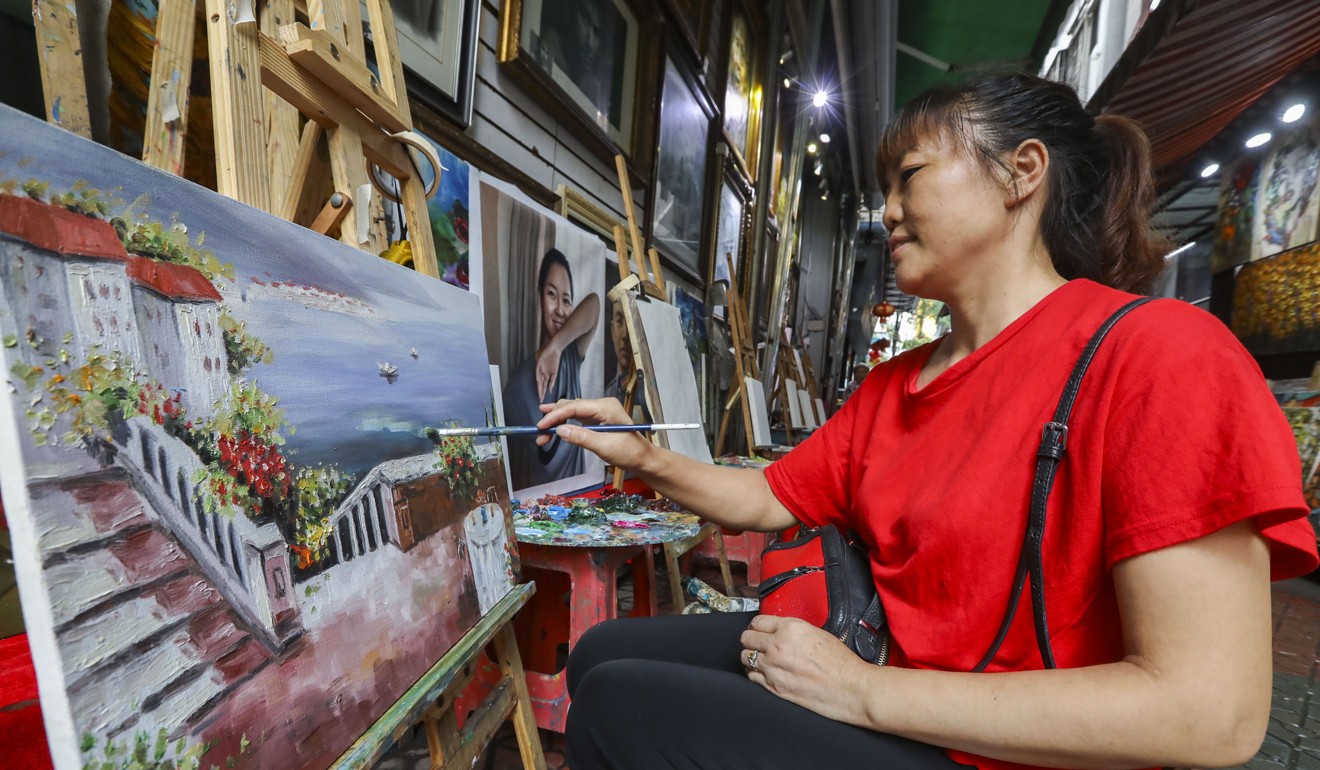
Trade war? China’s oil painters focused on domestic battles as US tariffs loom
Artists less affected by tariffs than they would have been a decade ago when they relied on exports, as China moves away from manufacturing-heavy era
Painters in a southern Chinese “art factory” village, once known for exporting most of the world’s oil paintings, were largely resigned to the newest threat to their business: the US-China trade war.
The artists of the Dafen Oil Painting Village in Shenzhen, already battling rising costs and declining market demand, quietly worked their paintbrushes in alleys and factory-style workshops, with little indication of the spectre of 10 per cent duties from Washington on Chinese paintings.
Handmade paintings, artistic drawings and pastels were all on the list of US$200 billion worth of goods that could become subject to US tariffs threatened last week, in a dispute Beijing has called the “largest trade war in history”. The measures could come into effect by August.
But in Dafen – an artsy hub once responsible for mass-producing 60 per cent of oil paintings globally, many of them replicas of masterpieces – artists say barriers to the US will simply further encourage the shift since the 2008 financial crisis, from a reliance on Europe and the US to the burgeoning domestic market, driven partly by the consumption power of China’s growing middle class.
Artist-turned-entrepreneur Jin Zhong is chairman of the Shenzhen Shangyi Oil Painting Company, which owns a handful of galleries in Dafen. His gallery is one of 1,200 remaining in a village whose annual revenue was estimated at US$630 million in 2015, but he said business had been hard.

“It used to be 80-20 in favour of foreign markets, but now it’s flipped,” he said, standing in front of landscape canvases of leafy golden trees and the mountains of southern China’s Guilin city.
“Business in the past few years has not been as good. Competition is very intense, and costs have gone up for labour, rent and materials.”
Such concerns also weigh heavily on the owners of Impression Gallery, tucked farther into the village at the end of a narrow alley. It specialises in imitations of Vincent van Gogh’s works, from the Dutch painter’s self-portraits to his irises series.

Its market in China has similarly surged, as people gained a greater understanding of Western art, to make up 80 per cent of its business, but rising costs loom larger.
“Business is a lot worse now – all our costs are much higher,” said Zhong Zaochun, one half of the couple who have run the gallery for two decades.
“If the US puts tariffs on [paintings from China], there will definitely be an impact,” she said. “Art buyers will have to shoulder the tariffs, so there will be an impact on us. But what can we do?”
Many in Dafen have turned increasingly to original paintings and works targeting Chinese audiences, rather than assembly-line copies of Rembrandt and Leonardo da Vinci.
The Chinese art buyers are the ones with the money, said He Xinlan, from the portrait-heavy Da Sheng Painting Shop, which takes requests for paintings of Chinese leaders such as President Xi Jinping and former leaders Sun Yat-sen, Mao Zedong and Deng Xiaoping.

“Foreigners are hard to sell to, since it feels like they think every cent more they spend is what we are scamming from them,” she said, in front of a wall of celebrity portraits.
“We’re selling 90 per cent to domestic buyers now. People will order Xi’s portraits for their offices.”
She said Dafen has been transformed in the past 20 years from a poor area dominated by rice fields and decaying houses to today’s clean, artsy enclave. But escalating costs have also forced her to raise prices from 300-400 yuan (US$45-60) per medium-range portrait up to 1,000 yuan.
“If I don’t raise my prices, I can’t eat,” He said.
The growth of the Chinese art market has benefited oil painter Yang Yongshi. Two of his nationalistic landscapes, on display this month in Dafen, have sold for 500,000 yuan (US$75,000) apiece.
“I won’t really consider market factors,” he said. “[Tariffs] are just a temporary issue.”
Elsewhere in China, too, oil painting exporters are braced for tariffs. One company in the southeastern province of Fujian, in the industry for almost 20 years, said it would have “no choice” but to raise prices if tariffs became reality.
Its manager, who declined to be named because his firm was already struggling, said business from the US had already slowed, making up only 20 per cent of his sales compared with over half in its heyday. Europe is now the firm’s largest market, with about 50 per cent of sales.
“If everyone else can survive [tariffs], we can too,” he said. “If everyone else cannot, we’ll just have to figure out our own way.”

